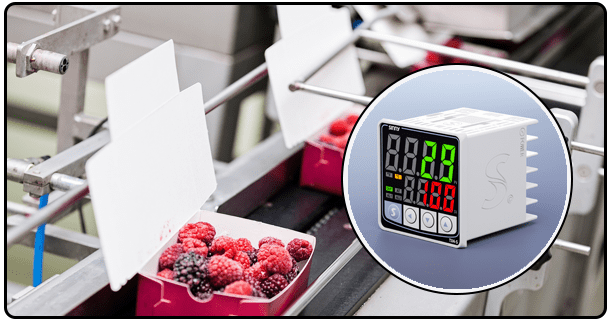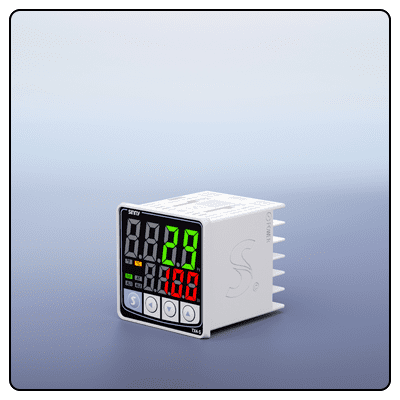Maximizing Output with PID Temperature Controllers
PID Temperature Controllers unlock the full potential of industrial processes by offering precise temperature regulation. Learn how precise control can increase stability, efficiency and output - ultimately guaranteeing consistent quality and peak productivity in competitive markets.
1. Introduction
Importance of Output Maximization in Industrial Processes
Output maximization is crucial in modern industry for maintaining profitability and meeting market demands, from chemical production to food processing, as it relies heavily on precise control mechanisms to achieve peak productivity. Achieve optimal output often necessitates facing numerous obstacles like consistent quality standards, minimal waste generation and optimal resource usage - challenges which necessitate advanced control systems which enhance process stability and efficiency.
2. Introduction to PID Controllers
PID (Proportional-Integral-Derivative) controllers, also referred to as Proportional-Integral-Derivative) controllers are sophisticated control mechanisms commonly found in industrial automation to regulate temperature, pressure and flow variables as part of industrial process automation. By continuously calculating an error value based on differences between desired setpoint and actual process variable values and actual process variable values a PID adjusts process inputs accordingly in order to minimize it thereby providing precise yet stable process control essential to maximize output in various industrial processes.
3. How PID Works
Proportional Control
PID temperature controllers use proportional terms that produce output values proportional to current error values; for large errors this means a proportional response from the controller; with smaller errors it has much smaller effects and may even help eliminate error altogether! Proportional controls help minimize overall errors but cannot completely eradicate them - however they play an essential part in stabilizing processes while producing close to desired setpoint values.
4. Integral Control
Integral control overcomes some of the limitations associated with proportional control by considering past errors that accumulate over time, effectively eliminating steady-state error and correcting even small persistent ones ensuring process variable reach setpoint as quickly as possible and remain there over time. Thus integral control ensures long-term process accuracy and consistency - essential components to maximize output and production output.
Derivative Control
Derivative control predicts future errors by taking into account their rate of change in process variables such as those related to production output. By considering an error's rate of change, derivative control provides dampening effects that reduce overshoot and oscillations while simultaneously increasing system stability and responsiveness allowing faster adjustments as conditions shift quickly in production environments. When combined together these three terms enable PID controllers to provide precise yet stable control essential for optimizing industrial output. PID Temperature Controller Benefits for Maximizing Output
5. Benefits of PID Controllers for Maximizing Output
Enhanced Process Stability
PID controllers' main strength lies in their ability to increase process stability. By eliminating oscillations and disturbances, PID controllers help maintain consistent production quality - this feature is especially crucial in processes where temperature variations could result in product defects or inconsistencies - such as chemical manufacturing where keeping temperatures within their target range ensures higher yields and increased output.
Increased Efficiency
PID controllers significantly enhance efficiency by optimizing resource use and minimizing waste, with precise control of process variables to make sure energy, raw materials and time resources are used as efficiently as possible to reduce operational costs while increasing overall productivity and profit. Their increased effectiveness often yields significant cost savings with an increase in profitability for industries where energy consumption plays an essential part of operations costs.
Faster Response to Changes
PID controllers' ability to respond rapidly to changes is one of their many key strengths, particularly their responsiveness to temperature variations or variations in raw material quality, is indispensable in maintaining optimal output. Quick adjustments ensure the process remains stable and efficient even under dynamic circumstances - an especially vital capability in industries characterized by frequent production process changes.
Precision and Accuracy
PID controllers' high precision and accuracy is indispensable in upholding product quality and consistency. By accurately maintaining setpoint temperatures, pressures or other process variables, PID controllers ensure the final product meets stringent quality standards - for instance during food processing when precise temperature control during baking or pasteurizing is critical in guaranteeing product safety and quality - this precision reduces risks while simultaneously improving process reliability thereby optimizing output and increasing output.
Scalability and Flexibility
PID controllers boast both scalability and adaptability, making them suitable for many industrial processes. Their seamless integration into existing systems and adaptability to specific process needs make PIDs ideal solutions, whether used for small-scale operations or larger industrial plants alike. PIDs offer consistent control while optimizing output across a broad spectrum of production scales while meeting individual user needs without compromise in quality or efficiency.
6. Case Studies or Examples
Example 1: Chemical Processing
In the chemical processing industry, precise temperature control is vital in optimizing reaction rates and yields. For instance, during polymer production processes it's crucial that maintaining an ideal polymerization temperature ensures desired molecular weights and properties for the finished product - PID controllers play an essential part here by maintaining it within its optimal range and thus lowering risks of side reactions while increasing yield - this ensures maximum output while simultaneously improving product quality and consistency!
Example 2: Manufacturing
Temperature stability in manufacturing processes like injection molding is vitally important in producing top-notch components. PID controllers ensure accurate temperature regulation within molding machines to avoid defects such as warping or incomplete filling resulting in higher production rates with reduced rejected parts, increasing output overall while simultaneously cutting energy usage costs and operational expenses while increasing productivity further. These gains also translate to significant energy consumption reduction as well as operational cost reduction - leading to enhanced productivity benefits from these efficiency gains. Implementation Strategies Depending upon implementation strategies chosen, strategies may vary; typically in manufacturing operations like injection molding machines use PID controllers ensure accurate temperature regulation ensure defects such as warping or incomplete filling can be avoided, leading to increased production rates with reduced rejected parts rates leading to an increase output increase while increasing energy savings cutting energy usage as well as operational cost saving efforts by up to 15%+ while improving energy consumption reducing operational costs by 10%+!.
Implementation Strategies
Selecting the Right PID Controller
Selecting an effective PID controller begins by understanding the requirements for the process at hand - such as temperature range, precision, response time and operating environment compatibility with existing systems. PID controllers with user-friendly interfaces and easy programming features make for faster setups and adjustments making them suitable for numerous industrial applications.
Proper Tuning and Calibration
Effective tuning and calibration are vital to the efficient functioning of PID controllers. Tuning involves adjusting proportional, integral, and derivative parameters until they achieve your desired response - techniques like Ziegler-Nichols can assist in finding suitable settings; regular calibration checks ensure accurate control is maintained over time by eliminating drift while providing consistent outputs.
Integration with Other Systems
Successful integration between PID controllers and existing automation/control systems is vital to their effectiveness, so setting up communication protocols such as Modbus or Ethernet to facilitate real-time data exchange is necessary for effective operation. Integrating them with supervisory control and data acquisition (SCADA) systems enables centralised process monitoring/optimization capabilities as well as increasing overall process optimization efforts.
Challenges and Solutions
Common Issues in PID Implementation
While PID controllers offer many advantages, implementation may present unique difficulties, including overtuning or undertuning that causes instability or slow response times; environmental influences like temperature extremes or electromagnetic interference could further hamper performance, so to properly address them requires meticulous tuning, installation procedures and protective measures against environmental effects.
Best Practices for Overcoming Challenges
In order to address implementation difficulties, best practices such as regular monitoring and maintenance should be adopted as essential tactics for meeting implementation hurdles. Routine inspections and calibration checks help identify any potential problems early, and continuous improvement practices, like analyzing process data or fine-tuning controller settings can further boost performance and output. Leveraging advanced features, like adaptive control or self-tuning capacities of PID controllers may further boost their efficacy in dynamic environments.
7. Conclusion
Summary of Key Points PID temperature controllers offer numerous advantages for increasing industrial output. Their abilities to increase process stability, enhance efficiency and provide precise control guarantee consistent product quality as well as high productivity levels. Their scalability and adaptability also makes PID temperature controllers suitable for various applications ranging from small scale operations to industrial plants.
- Top Industries Benefiting from PID Temperature Controllers
- How to Maintain Your PID Temperature Controller for Longevity























